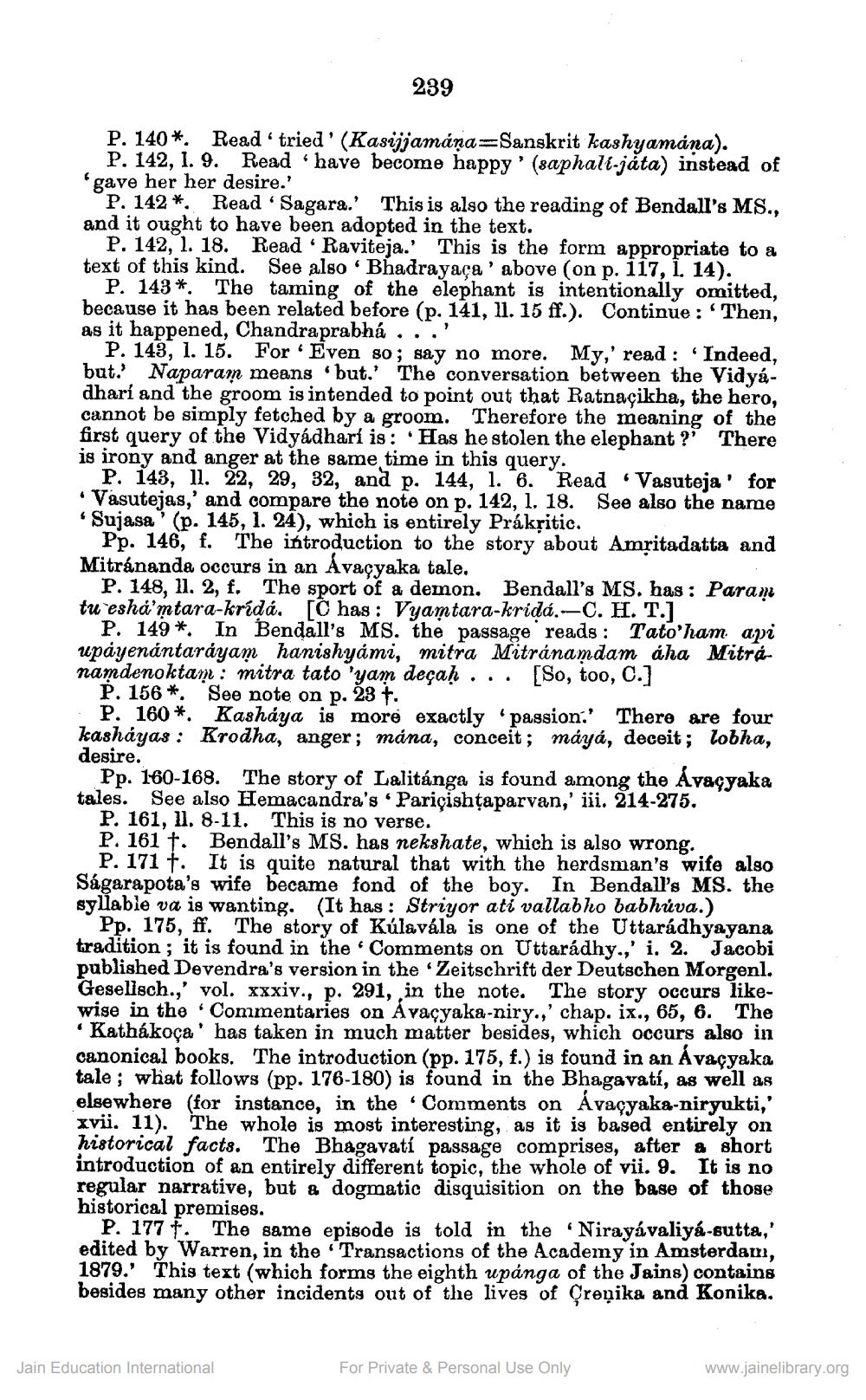________________
239
P. 140 *. Read tried' (Kasijjamána=Sanskrit kashyamána).
P. 142, 1. 9. Read have become happy' (saphali-játa) instead of gave her her desire.'
P. 142*, Read . Sagara.' This is also the reading of Bendall's MS., and it ought to have been adopted in the text.
P. 142, 1. 18. Read Raviteja.' This is the form appropriate to a text of this kind. See also Bhadrayaca' above (on p. 117, 1. 14).
P. 143*. The taming of the elephant is intentionally omitted, because it has been related before (p. 141, 11. 15 ff.). Continue : Then, as it happened, Chandraprabhá...'.
P. 143, 1. 15. For Even so; say no more. My,' read: Indeed, but.' Naparam means but.' The conversation between the Vidyadhari and the groom is intended to point out that Ratnaçikha, the hero, cannot be simply fetched by a groom. Therefore the meaning of the first query of the Vidyadhari is: 'Has he stolen the elephant ?' There is irony and anger at the same time in this query.
P. 143, 1l. 22, 29, 32, and p. 144, 1. 6. Read Vasuteja' for • Vasutejas,' and compare the note on p. 142, 1. 18. See also the name * Sujasa' (p. 145, 1. 24), which is entirely Prákritic.
Pp. 146, f. The introduction to the story about Amritadatta and Mitránanda occurs in an Avaçyaka tale,
P. 148, 11, 2, f. The sport of a demon. Bendall's MS. has : Param tu esha'mtara-krídá. [has: Vyamtara-kridá.-C. H. T.]
P. 149*. In Bendall's MS. the passage reads : Tato'han api upayenántaráyam hanishyámi, mitra Mitránamdam áha Mitra namdenoktam : mitra tato 'yam decah ... [So, too, C.]
P. 156*. See note on p. 23 t.
P. 160*. Kasháya is more exactly passion.' There are four kasháyas : Krodha, anger; mana, conceit; máyá, deceit; lobha, desire.
Pp. 160-168. The story of Lalitánga is found among the Ayaçyaka tales. See also Hemacandra's Pariçishtaparvan,' iii. 214-275.
P. 161, 11. 8-11. This is no verse. P. 161 t. Bendall's MS. has nekshate, which is also wrong.
P. 171 t. It is quite natural that with the herdsman's wife also Ságarapota's wife became fond of the boy. In Bendall's MS. the syllable va is wanting. (It has : Striyor ati vallabho babhúva.)
Pp. 175, ff. The story of Kúlavála is one of the Uttaradhyayana tradition ; it is found in the Comments on Uttaradhy.,' i. 2. Jacobi published Devendra's version in the Zeitschrift der Deutschen Morgenl. Gesellsch.,' vol. xxxiv., p. 291, in the note. The story occurs likewise in the Commentaries on Avaçyaka-niry.,' chap. ix., 65, 6. The
Kathákoça' has taken in much matter besides, which occurs also in canonical books. The introduction (pp. 175, f.) is found in an Avaçyaka tale; what follows (pp. 176-180) is found in the Bhagavatí, as well as elsewhere (for instance, in the Comments on Avaçyaka-niryukti,' xvii. 11). The whole is most interesting, as it is based entirely on historical facts. The Bhagavatí passage comprises, after a short introduction of an entirely different topic, the whole of vii. 9. It is no regular narrative, but & dogmatic disquisition on the base of those
reguorical premthe samne Trans
P. 177 . The same episode is told in the Nirayávaliya-sutta,' edited by Warren, in the Transactions of the Academy in Amsterdam, 1879.' This text (which forms the eighth upanga of the Jains) contains besides many other incidents out of the lives of Creņika and Konika.
Jain Education International
For Private & Personal Use Only
www.jainelibrary.org




